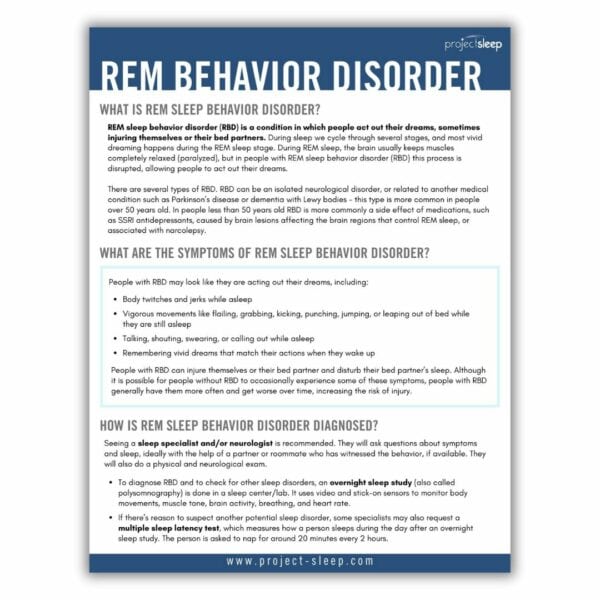REM Sleep Behavior Disorder (RBD) is a condition that causes people to act or talk out their dreams (dream enactment) during their rapid eye movement (REM) sleep cycle.
REM Sleep Behavior Disorder (RBD)
What is REM Sleep Behavior Disorder (RBD)?
REM sleep behavior disorder (RBD) is a condition in which people act out their dreams, sometimes injuring themselves or their bed partners.
During sleep we cycle through several stages. Most vivid dreaming happens during the REM sleep stage. During REM sleep, the brain usually keeps muscles completely relaxed (paralyzed), but in people with RBD, this process is disrupted, allowing people to act out their dreams.
People with RBD act out their dreams due to disrupted REM functioning.
There are several types of RBD. RBD can be an isolated neurological disorder, or related to another medical condition such as Parkinson’s disease or dementia with Lewy bodies – this type is more common in people over 50 years old. In people less than 50 years old RBD is more commonly a side effect of medications, such as SSRI antidepressants, caused by brain lesions affecting the brain regions that control REM sleep, or associated with narcolepsy.
What are the symptoms of RBD?
People with RBD may look like they are acting out their dreams, including:
- Body twitches and jerks while asleep
- Vigorous movements like flailing, grabbing, kicking, punching, jumping, or leaping out of bed while they are still asleep
- Talking, shouting, swearing, or calling out while asleep
- Remembering vivid dreams that match their actions when they wake up
People with RBD can injure themselves or their bed partner and disturb their bed partner’s sleep. Although it is possible for people without RBD to occasionally experience some of these symptoms, people with RBD generally have them more often and get worse over time, increasing the risk of injury.
How is RBD diagnosed?
Seeing a sleep specialist and/or neurologist is recommended for people who are experiencing symptoms that indicate they may be living with RBD.
A sleep specialist or neurologist will ask questions about your symptoms and sleep, ideally with the help of a partner or roommate who has witnessed the behavior, if available. They will also do a physical and neurological exam.
To diagnose RBD and check for other sleep disorders, an overnight sleep study (polysomnography) is done in a sleep center/lab. This study uses video and stick-on sensors to monitor body movements, muscle tone, brain activity, breathing, and heart rate.
If there’s reason to suspect another potential sleep disorder, some specialists may also request a multiple sleep latency test. This test measures how a person sleeps during the day after an overnight sleep study. The person is asked to nap for around 20 minutes every 2 hours.
How is RBD treated?
The best choice of treatments for each person with RBD depends on the type and cause of RBD and co-existing medical conditions.
Bedroom safety precautions can reduce the risk of injury for those with RBD and their loved ones. Precautions could include:
- removing weapons from the bedroom
- moving objects that could cause injury away from the bed
- padding hard furniture
- putting a soft rug by the bed
- moving the bed away from windows
- placing a large object like a dresser in front of windows
- having a barrier (e.g., pillows) between the person with RBD and their bed partner, or the bed partner sleeping in a separate bed
It is possible that certain medications may cause RBD symptoms. Discuss discontinuing these medications with your doctor. Other sleep disorders may also make RBD symptoms worse, and finding proper treatment could help.
Helpful lifestyle strategies include keeping healthy sleep habits (also called sleep hygiene) and learning about RBD.
Social support, through connecting with other people who have RBD and their families, can empower people to understand RBD and learn strategies to live well with RBD.
RBD can be an isolated neurological disorder or related to another medical condition such as Parkinson’s disease or dementia with Lewy bodies. Regular monitoring for symptoms that could be a sign of other neurological disorders, such as tremors, is important.
Medications may be prescribed for people with isolated RBD or secondary RBD due to a medical condition, including clonazepam and melatonin. Pramipexole may be helpful for people with isolated RBD. Rivastigmine can be helpful in people who also have mild cognitive impairment or Parkinson’s disease.
Additional REM Sleep Behavior Disorder Resources
Please download our free, printable RBD Fact Sheet and share with friends, family, and medical providers.

